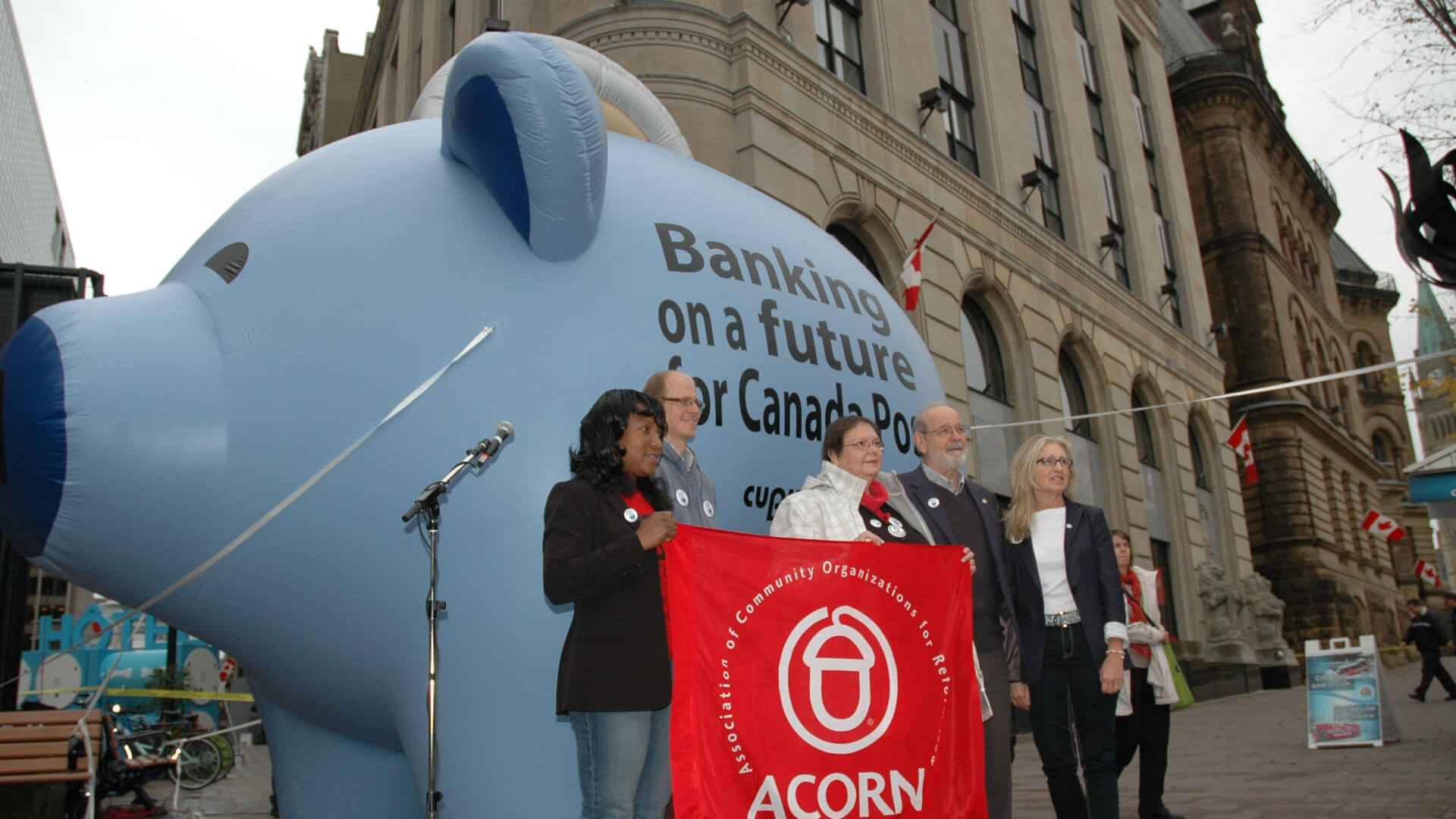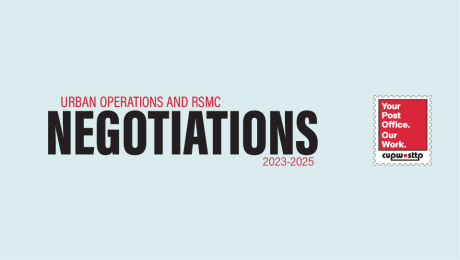News and Events
Share This
Media Enquiries
Events Calendar
By Issue
By Subject
By Type
- (-) Remove Backgrounders filter Backgrounders
- Calendar (1) Apply Calendar filter
- Events (1) Apply Events filter
- Fact Sheets (2) Apply Fact Sheets filter
- Guides and Booklets (2) Apply Guides and Booklets filter
- Reports (7) Apply Reports filter
- (-) Remove Resources filter Resources
- Surveys & Polls (1) Apply Surveys & Polls filter
By Date
CUPW National Office
377 Bank Street
Ottawa, Ontario K2P 1Y3
Canada
Tel: (613) 236-7238
Fax: (613) 563-7861
TTY: (613) 236-9753
Showing 1 - 10 of 23 results
Pages
Friday March 1 2019
Monday January 22 2018
Pages
Latest Content
Wednesday October 23 2019
These are pocket-sized reference cards about the right to refuse unsafe work. Locals or individual members can print and cut them out from the pdf files on cupw.ca. Locals without the means to print the cards may order the quantity needed from the national office’s print shop, to the attention of [email protected]
Friday March 1 2019
Saturday September 1 2018
This resource guide is meant to help parents and guardians of children with disabilities navigate theschool system in their province or territory. Our aim is to help you better understand your legal rights and help you advocate for your children by asking the “right” questions of everyone involved in your child’s education.
Monday January 22 2018
Despite considerable media coverage about the difficulty of finding licensed child care spaces, most prospective parents wait far too long before trying to apply for one. Many parents don’t think about their child care arrangements until late into their pregnancy or well into their maternity/parental leave.
To better understand how parents learn about child care and how best to get information into their hands early CUPW partnered with the Child Care Resource and Research Unit (CRRU) to survey CUPW members who were on maternity/parental leave.
We gained a number of insights into the best ways to communicate with members and about the kind of information they need. We learned word of mouth (family, friends and coworkers) is one of the main sources of information. So too is social media. Members also want information about how to apply for child care and about government fee subsidies. Many members talked about wanting to better understand their rights and the process to apply for EI maternity/parental leave, work accommodation and other work/life balance issues. These findings will help inform the work of the CUPW Child Care Fund over the coming months and years.
Wednesday December 20 2017
This paper is the latest in a series of annual survey reports that track child care fee subsidy rates across the country. Time Out 2017 follows three earlier surveys: The Parent Trap (2014), They Go Up So Fast (2015) and A Growing Concern (2016). The data shows that policy matters when it comes to parental fees with provinces providing operational funding consistently showing the lowest fees. Without doubt, child care fees in most of Canada are far too expensive for many. While the ongoing child care fee data is filling an important gap, fees are only part of the puzzle of how parents are coping with finding care for their children.
Thursday November 17 2016
A resource guide for the CUPW Child Care Fund documenting three success stories. It shows how the union can help CUPW members find child care solutions, and pressure governments to fund child care initiatives.
Monday November 7 2016
This study, the third in a series beginning in 2014, reveals the most and least expensive cities for child care in Canada.
Monday October 24 2016
This page provides information intended to help parents understand and find child care in each province and territory. Below is an overview of the kinds of search and access tools that will be useful for parents.
- 1 of 3
- next ›
Support Postal Banking - Download and Sign the Petition
Canada needs a postal bank. Thousands of rural towns and villages in our country do not have a bank, but many of them have a post office that could provide financial services. As well, nearly two million Canadians desperately need an alternative to payday lenders. A postal bank could be that alternative. Download and sign the petition urging the Government of Canada to instruct Canada Post to add postal banking, with a mandate for financial inclusion.
Latest Content
Thursday August 14 2025
Unfortunately, our scheduled meetings for Friday, August 15th and Monday, August 18th, have been postponed. The Federal mediators will not be able to assist CUPW and CPC due to their current involvement in the Air Canada negotiations.
Thursday August 14 2025
This September, CUPW joins its Malayali brothers and sisters with joy and pride to observe Onam celebrations in Canada. Onam is one of the most significant regional festivals celebrated in Kerala, the southernmost state of India.
Wednesday August 13 2025
After pressing the Employer to come back to the bargaining table early last week, we received a response from Canada Post CEO Doug Ettinger on Friday evening, just hours after we posted Bulletin 128, “CUPW is Waiting for Canada Post.” In his letter, Mr. Ettinger stuck to the lines we’ve heard from Canada Post for many months now.
Friday August 8 2025
A week ago, CUPW members spoke loudly and rejected what Canada Post called its “best and final” offers. The goal of the Canadian Union of Postal Workers remains negotiating ratifiable collective agreements which meet postal workers’ needs, help grow the current services provided by a public post office and to better serve Canadians with new services.
Wednesday August 6 2025
Last week, postal workers decisively rejected Canada Post’s “best and final offers” in the government-forced vote. With a turnout of over 80%, nearly 70% of our members told Canada Post, “No, these offers won’t do it!”
Every employer in the Federal and Provincial sector has been watching us. Rejecting these offers was a victory not only for our Union, but for the labour movement as a whole.
Tuesday August 5 2025
To all CUPW members,
Thank you for showing up, for standing together, and for participating in the government forced vote. Regardless of how you voted, your participation was an act of solidarity and strength. And for those who voted to reject the final offers, your decision sent a powerful message: “We know our worth, and we deserve better”.
Friday August 1 2025
After almost two weeks of voting, the results are now in: CUPW members in both bargaining units have spoken, and they have rejected Canada Post’s global offers.
Tuesday July 29 2025
We’ve now entered the second and final week of the government-imposed forced vote on Canada Post’s “final” offers. As of July 28, 69 % of Urban members and 71.4 % of RSMC members have already casted their vote. Voting continues until 5 pm EST on August 1.
Tuesday July 29 2025
On March 24, 2021, the House of Commons voted to designate August 1st as Emancipation Day to commemorate the slavery abolition act of 1833, which took effect in 1834 and paved the way for the liberation of over 800,000 enslaved Black people across the “British Empire”, including parts of the Caribbean, Africa, South America and Canada.
Friday July 25 2025
On July 23, Canada Post shared some information about its “final” offers and the vote that is currently underway with members. Information was shared via email as well as distributed in some workplaces.
- 1 of 185
- next ›

Our Events Calendar lets you stay up to date.
We also issue bulletins and media releases to our members and the media.
Popular Issues
Copyright © 2025 Canadian Union of Postal Workers and its licensors. All rights reserved.
Copyright © 2025 Syndicat des travailleurs et travailleuses des postes et ses concédants. Tous droits réservés.







